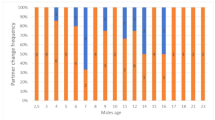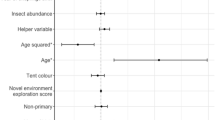Abstract
Active pursuit of extra-pair mating has been reported for Indri indri, the socially monogamous largest living lemur. This study, conducted in a mountain rainforest in eastern Madagascar, presents the first evidence for extra-pair mating of indri and discusses the alternative mating strategy and alteration of the social, territorial, spatial, and vocal behavior of the adult female of a group of wild indris. Further studies may investigate whether extra-pair copulation is an attempt to breed with a partner of superior quality and thus lead to extra-pair paternity. If so, it could potentially play a role in maintaining genetic variability within a population.
Similar content being viewed by others
References
Altmann J (1974) Observational study of behavior: sampling methods. Behav 49:227–267 [Reprinted in: Houck LD and Drickamer LC (eds) Foundations of Animal Behavior. U Chicago Press, 1996]
Barlow GW (1970) A test of appeasement and arousal hypotheses of courtship behavior in a cichlid fish, Etroplus maculatus. Zeitschrift für Tierpsychologie 27:779–806
Bercovitch FB (1988) Coalitions, cooperation and reproductive tactics among adult male baboons. Anim Behav 36:1198–1209
Birkhead TR, Møller AP (1992) Sperm competition in birds: evolutionary causes and consequences. Academic Press, London
Brockelman WY, Reichard U, Treesucon U, Raemaekers JJ (1998) Dispersal, pair formation, and social structure in gibbons (Hylobates lar). Behav Ecol Sociobiol 42:329–339
Digby LJ (1999) Sexual behavior and extragroup copulations in a wild population of common marmosets (Callithrix jacchus). Folia Primatol 70:136–145
Fietz J, Zischler H, Schwiegk C, Tomiuk J, Dausmann KH, Ganzhorn JU (2000) High rates of extra-pair young in the pair-living fat-tailed dwarf lemur, Cheirogaleus medius. Behav Ecol Sociobiol 49:8–17
Fisher RA (1930) The genetical theory of natural selection. Clarendon Press, Oxford
Gamba M, Favaro L, Torti V, Sorrentino V, Giacoma C (2011) Vocal tract flexibility and variation in the vocal output in wild indris. Bioacoustics 20:251–265
Giacoma C, Sorrentino V, Rabarivola C, Gamba M (2010) Sex differences in the song of Indri indri. Int J Primatol 31:4539–4551
Gray EM (1997) Do female red-winged blackbirds benefit genetically from seeking extra-pair copulations? Anim Behav 53:605–623
Hamilton WD, Zuk M (1982) Heritable true fitness and bright birds: a role for parasites? Science 218:384–387
Hervieu J (1960) Notice sur les cartes pédologiques de reconnaissance 1/200000 Feuille n3. Brickaville- Moramanga. IRSM. p 67
Isbell LA, Van Vuren D (1996) Differential costs of locational and social dispersal and their consequences for female group-living primates. Behav 133:1–36
Isvaran K, Clutton-Brock T (2007) Ecological correlates of extra-group paternity in mammals. Proc Biol Sci 274:219–224
Kappeler PM, van Schaik CP (2004) Sexual selection in primates: review and selective preview. In: Sexual Selection in Primates. Cambridge: Cambridge University Press (Kappeler PM, van Schaik CP eds.) pp 3–23
Kempenaers B, Dhondt AA (1993) Why do females engage in extra-pair copulations? A review of hypotheses and their predictions. Belg J Zool 123:93–103
Kempenaers B, Verheyen GR, Van den Broeck M, Burke T, Van Broeckhoven C, Dhondt AA (1992) Extra-pair paternity results from female preference for high quality males in the blue tit. Nature 357:494–496
Kleiman DG (1977) Monogamy in mammals. Q Rev Biol 52:39–69
Komers PE, Brotherton PN (1997) Female space use is the best predictor of monogamy in mammals. Proc Biol Sci 264:1261–1270
Lawler RR (2007) Fitness and extra-group reproduction in male Verreaux’s sifaka: an analysis of reproductive success from 1989–1999. American journal of physical anthropology, Wiley Online Library
Maretti G, Sorrentino V, Finomana A, Gamba M, Giacoma C (2010) Not just a pretty song: an overview of the vocal repertoire of wild indris. J Anthropol Sci 88:151–165
Mason WA (1966) Social organization of the South American monkey, Callicebus moloch: a preliminary report. Tulane Stud Zool 13:23–28
Matsumoto-Oda A, Hamai M, Hayaki H, Hosaka K, Hunt KD, Kasuya E, Kawanaka K, Mitani JC, Norikoshi K, Takasaki H, Takahata Y (2007) Estrus cycle asynchrony in wild female chimpanzees, Pan troglodytes schweinfurthii. Behav Ecol Sociobiol 61:661–668
Maynard Smith J (1977) Parental investment: a prospective analyses. Anim Behav 25:1–7
Mittermeier RA, Konstant WR, Hawkins F, Louis EE, Langrand O, Ratsimbazafy J, Rasoloarison R, Ganzhorn JU et al. (2006) Lemurs of Madagascar. Conservation International 391–403
Møller AP (1990) Sexual behavior is related to badge size in the house sparrow Passer domesticus. Behav Ecol Sociobiol 27:23–29
Oka T, Takenaka O (2001) Wild gibbons’ parentage tested by non-invasive DNA sampling and PCR-amplified polymorphic microsatellites. Primates 42:67–73
Packer C (1979) Male dominance and reproductive activity in Papio anubis. Anim Behav 27:37–45
Palombit RA (1994a) Dynamic pair bonds in hylobatids: implications regarding monogamous social systems. Behaviour 128:65–101
Palombit RA (1994b) Extra-pair copulations in a monogamous ape. Anim Behav 47:721–723
Petter JJ, Peyriéras CD (1979) Vocal communication in prosimians; the study of prosimian behavior. In: Doyle GA, Martin RD (eds) The study of prosimian behaviour. Academic Press, New York, pp 272–282
Pollock JI (1975a) Field observations on Indri indri: a preliminary report. In: Tattersall I, Sussman RW (eds) Lemur Biology. Plenum Press, New York, pp 287–311
Pollock JI (1975) The social behavior and ecology of Indri indri. PhD thesis, University College London
Pollock JI (1979) Female dominance in Indri indri. Folia Primatol 31:143–164
Pollock JI (1986) The song of the indri (Indri indri; Primates; Lemuroidea): natural history, form, and function. Int J Primatol 7:225–264
Powzyk JA (1997) The socio-ecology of two sympatric indriids: Propithecus diadema diadema and Indri indri. A comparison of feeding strategies and their possible repercussions on species–specific behaviors. Ph.D. dissertation, Duke University, Durham, NC
Powzyk J, Thalmann U (2003) Indri indri, Indri. In: Goodman SM, Benstead JP (eds) The natural history of Madagascar. University of Chicago Press, Chicago, pp 1342–1345
Reichard U (1995) Extra pair copulations in a monogamous gibbon (Hylobates lar). Ethol 100:99–112
Reichard UH, Boesch C (2003) Monogamy: mating strategies and partnership in birds, humans and other mammals. Cambridge University Press, Cambridge, p 267
Samuels A, Silk JB, Rodman PS (1984) Changes in the dominance rank and reproductive behaviour of male bonnet macaques (Macaca radiata). Anim Behav 32:994–1003
Schülke O, Kappeler PM, Zischler H (2004) Small testes size despite high extra-pair paternity in the pair-living nocturnal primate Phaner furcifer. Behav Ecol Sociobiol 55:292–301
Shively C, Smith DG (1985) Social status and reproductive success of male Macaca fascicularis. Am J Primatol 9:129–135
Smith SM (1988) Extra-pair copulations in black-capped chickadees: the role of the female. Behav 107:15–23
Sorrentino V, Gamba M, Giacoma C (2013) A quantitative description of the vocal types emitted in the indri’s song. In: Masters JC, Gamba M, Genin F (eds) Leaping ahead: advances in prosimian biology. Springer, New York
Tardif SD (1994) Relative energetic cost of infant care in small bodied Neotropical primates and its relation to infant-care patterns. Am J Primatol 34:133–143
Torti V (2013) Mating system and communication in Indri indri. PhD thesis, University of Torino
Torti V, Sorrentino V, Giacoma C, Gamba M (2010) Acoustic potential for reference-like communication in wild indris. In: Smith ADM, Schouwstra M, De Boer B, Smith K (eds) The evolution of language. World Scientific, pp 505–506
Trivers RL (1972) Parental investment and sexual selection. In: Campbell B (ed) Sexual Selection and the Descent of Man. Aldine, Chicago, pp 136–179
Wagner RH (1991) The role of extra-pair copulation in razorbill mating strategies. PhD Thesis. University of Oxford
Westneat DF, Sherman PW, Morton ML (1990) The ecology and evolution of extra-pair copulations in birds. Curr ornithol 7:331–369
Wright PC (1990) Demography and life history of free-ranging Propithecus diadema edwardsi in Ranomafana National Park, Madagascar. Int J Primatol 5:835–854
Zahavi A (1975) Mate selection: a selection for a handicap. J Theor Biol 53:205–214
Acknowledgments
This occurrence of EPC was recorded during a larger field study of Indri indri supported by the Università degli Studi di Torino and the ACP Science and Technology Programme of the ACP Group of States, with the financial assistance of the European Union, through the Projects BIRD (Biodiversity Integration and Rural Development; no. FED/2009/217077) and SCORE (Supporting Cooperation for Research and Education; Contract no. ACP RPR 118 # 36) and by grants from the Parco Natura Viva—Centro Tutela Specie Minacciate. We are grateful to Compagnia di San Paolo for co-financing the “Progetto 2008-10 Innovazione Laboratori didattici—Facoltà di Scienze MFN” which enabled the purchase of laboratory equipment used by G.B. and V.T. during field activity. We thank the Ministère de l’Environnement et des Forêts (MEF) and Madagascar National Parks for granting the research permits. We are also grateful to GERP (Groupe d’Etudes et des Recherche sur les Primates) for allowing us to collect data in the forest under its management. Last, we thank Dr Cesare Avesani Zaborra and Dr Caterina Spiezio for their important role in organization of the Maromizaha field station and all the research and international guides, Dr Olivier Friard for helping during data analysis, Lanto and Mamatin for their help and logistic support, Dr Dominic Currie and Dr Caroline Harcourt for linguistic revision and two anonymous referees. The contents of this document are the sole responsibility of the authors and can in no circumstances be regarded as reflecting the position of the European Union.
Author information
Authors and Affiliations
Corresponding author
Electronic supplementary material
Below is the link to the electronic supplementary material.
About this article
Cite this article
Bonadonna, G., Torti, V., Randrianarison, R.M. et al. Behavioral correlates of extra-pair copulation in Indri indri . Primates 55, 119–123 (2014). https://doi.org/10.1007/s10329-013-0376-0
Received:
Accepted:
Published:
Issue Date:
DOI: https://doi.org/10.1007/s10329-013-0376-0




